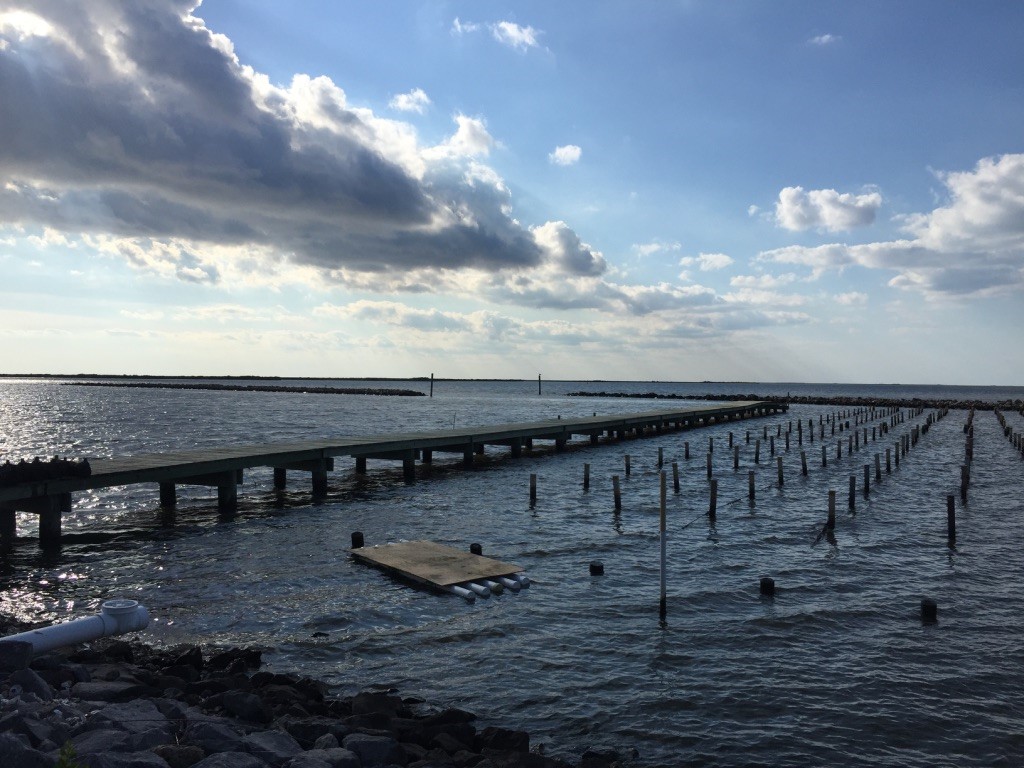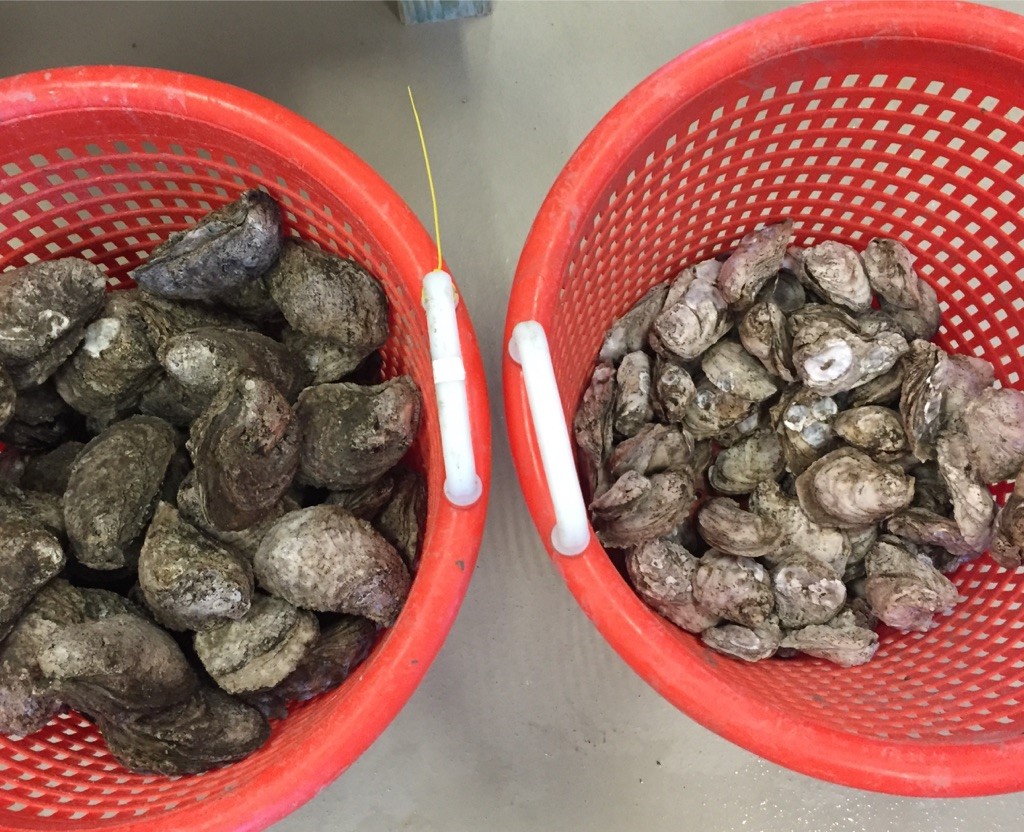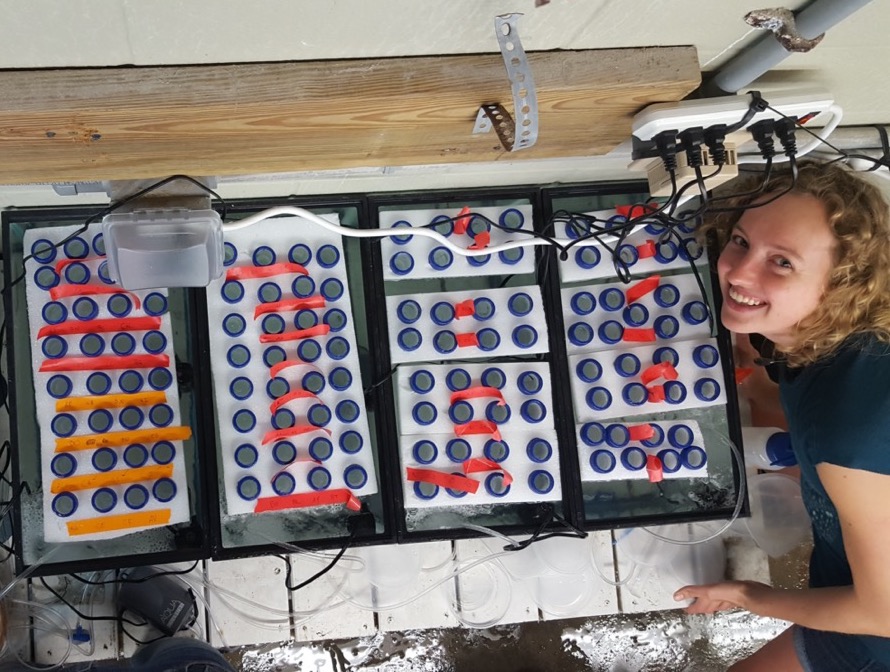To Breed An Oyster
12:08 minutes

In the ocean, climate change involves more than just warming temperatures. Water levels are shifting, and ocean chemistry is changing. Changes to ocean salinity caused by shifting amounts of freshwater could have big effects on the health of oysters, who need a certain range of saltiness in the water to be happy.
As part of her doctoral work at Louisiana State University, researcher Joanna Griffiths bred hundreds of families of oysters, looking for clues to what makes an oyster more able to endure salinity changes. She found that there is a genetic component to an oyster’s salinity resilience.


Griffiths joins SciFri’s Charles Bergquist to talk about the work, and the challenges of conducting a laboratory oyster breeding program—in which it’s difficult convince an oyster that it’s time for romance, and often even hard to discern the sex of the oysters involved.
Joanna Griffiths is a postdoctoral student at the University of California, Davis in Davis, California.
IRA FLATOW: This is Science Friday. I’m Ira Flatow. Later in the hour, we’re going to kick off the Charismatic Creature Carnival. Yay. But first, Louisiana is still working to recover from Hurricane Ida, a storm made worse by the warming waters of a changing climate. Climate change is affecting that region’s wildlife, too, and what we all eat. Here with the details is SciFri’s Charles Bergquist. Hi, Charles.
CHARLES BERGQUIST: Hey, Ira. Today, we’re talking about oysters.
IRA FLATOW: Oysters. That is big business in Louisiana.
CHARLES BERGQUIST: Yeah. Around 70% of the oysters caught in the US are harvested on the Gulf Coast, so naturally folks there are interested in the potential effects of things like climate change.
IRA FLATOW: You know, this makes sense because I imagine it must be something like corals bleaching when they get too warm.
CHARLES BERGQUIST: It’s actually more complicated than that. Climate change doesn’t just mean warmer water, it means changes in water levels, and in water chemistry, too. I talked with Joanna Griffiths. Her doctoral work at Louisiana State University involved breeding different oysters to see how they were able to adapt to changes in ocean salt concentrations. It turns out a few parts per thousand can make a big difference to an oyster, and water levels are shifting.
JOANNA GRIFFITHS: In Louisiana, because they’re in, like, Hurricane Alley, they’re actually getting tons and tons of fresh water, and then there’s also the Mississippi River right there, which is just dumping huge amounts of fresh water into the estuary and where the oysters live. Louisiana, trying to deal with their subsidence issues, one of the things they’re going to do is divert more fresh water out of the Mississippi. And so it’s like climate change and also, like, human alterations to the environment, where we’re actually physically going to be putting more fresh water on these oysters, which is also really stressful for them.
CHARLES BERGQUIST: How tight a range does the salinity need to be in for an oyster to do well? What are the boundaries there?
JOANNA GRIFFITHS: Actually, oysters are really, really good at handling a really wide breadth of salinities. You can find them in full-strength seawater, which is around 35 PPT, and then also as low as 3 PPT, which is, like, pretty close to like fresh water. And they can handle all of this [INAUDIBLE] it’s just that they can’t handle it for very long. So if they’re in the 3 PPT for more than a few weeks or so, then it starts getting, like, pretty stressful for them. And then it’s a little different for the larvae or the really juvenile oysters because they don’t have as much capabilities of dealing with that really low salinity water for as long as the adult oysters.
CHARLES BERGQUIST: So you were looking at how to get oysters to be more resilient to some of these changes that we were talking about. I’m going to start by saying that I know next to nothing about oyster reproduction. In the wild, how does it happen?
JOANNA GRIFFITHS: Oysters are kind of, like, found all in, like, groups together. And so usually, it’s like during the summer months when it starts to get a bit warmer, and then one oyster decides, oh, it’s looking really great out here, time to start releasing all of my milk or my eggs. And then once one oyster starts going, the one next to it is like, oh man, I’ve got to get going, too.
And so they all just sort of, like, release everything into the water column. And then the sperm and egg find each other, and then you have fertilization in the water column. And then after around, like, 10 days or so, that little embryo will sink to the bottom of the floor, and try and find somewhere where it can settle down and get, like, a firm grasp so that they can start feeding.
CHARLES BERGQUIST: So that’s what would happen naturally, but you’re trying to do this in controlled conditions in your lab. How does that work? How different is it?
JOANNA GRIFFITHS: Yeah, it’s really hard to get oysters to want to spawn. So there’s like a few little tricks that we’ve done. And one of the reasons it was also a little bit more difficult for my experiment is that, because I want to cross one specific parent with another one, I have to know that the eggs and sperm are coming from that particular oyster. So we can’t really do these big spawns of all of them in the group.
And so what you can do, you can sort of mimic what’s happening in the wild. You can put them in their own little individual tank, and then you sort of heat up the water. And oysters have this freakout response, where they’re like, oh no, it’s getting really stressful out there. I don’t know what’s going to happen next. I better start reproducing as fast as possible. But that doesn’t always work for all of the oysters.
Some of them are really stubborn. And so what you can also do, you can just like open them up, which unfortunately means that they will die, since you’re opening. And then you can, like, do what we call strip spawning, where you just basically cut out the eggs and sperm manually. And then we add it to salt water, and then we add the salt water of the sperm and eggs together, and then just let the rest happen itself.
CHARLES BERGQUIST: You’re using certain tricks to make the oysters think it’s time for romance. You talked about sort of increasing their stress level by warming the tank. Are there are other things that you do?
JOANNA GRIFFITHS: Yeah, there are a few other tricks. You can collect a little bit of sperm from one of the males, and then when you can make that sperm infertile by putting it in the microwave just for a few seconds and basically killing everything. But it still has like all the chemical cues that would maybe potentially initiate other oysters to start spawning. So with that now infertile sperm, we can just add little drops to where the other oysters are located, and hopefully those chemical cues get them going.
But oysters will also not spawn if they’re not ready. So if their eggs are still not quite ripe yet, then, like, none of these tricks will really work. And then you don’t really know what the problem is until you open up that oyster. And you can actually physically see and tell that the eggs are just, like, not ready to go sometimes.
So we’ll have to just, like, set that female aside and be like, OK, she won’t produce any viable offspring, which is another problem, too, because sometimes you can tell and you think they look fine, and then you go through all the fertilization steps, and then you look to see if you have any little embryos swimming around a few days later, and there’s absolutely nothing there. And you’re like, oh, OK. So I think I made over, like, 250 families, and I think at the end of the experiment, only 30% survived. Like, I think it was probably a combination of just, like, the eggs just weren’t ready to go, or it was just a bad match and they were potentially incompatible. And so didn’t have any viable offspring from those families.
CHARLES BERGQUIST: If I’m on the beach or in a restaurant, say, can an ordinary human look at an oyster and tell if it’s male or female?
JOANNA GRIFFITHS: No, actually you can’t. It’s really hard. And even when the oyster releases its eggs or sperm into the water column, it’s microscopic. Like, you’ve got to take out a little sample and put it under a microscope. Another really annoying thing of oysters is that when you’re trying to do these experiments, you need, like, 50% females and 50% males, but oysters, actually 3/4 of them I believe are male when they’re around that young age, maybe like a year or two old. So most of them start off male, and then some of them later in life will decide to switch, and they’ll become females. And so as they get older, then you have this more like 50-50 ratio of males to females. But a lot of oysters will just switch halfway through their life, and they’ll just become females after a little bit.
CHARLES BERGQUIST: So when you’re in your lab and you’re trying to pair one specific oyster with another specific oyster, you don’t even know if they’re compatible sexes.
JOANNA GRIFFITHS: Yeah, so the first step is just trying to get them to spawn. And then you’ve got to figure out, OK, was this a male or female? And then if it’s one of those, I can be like, OK, this one is going to get crossed with this male, and this female is going to get crossed with this other male. So I sort of have to, like, wait and see what I have. And because they had this specific breeding design that I was following, I kept having to spawn more and more oysters because I didn’t have enough females to go around with all of these males.
CHARLES BERGQUIST: What’s the sort of end goal here? Do you envision people then taking your most successful ones and cross-breeding them, and seeing if you can get to, like, level two or level four? Or is this where it ends?
JOANNA GRIFFITHS: So I guess the main goals of the experiment was sort of see what are the different tools that these oysters have for surviving in these really stressful salinities. And one of the tools they have in their toolkit is their, like, genetics, which oysters have the right genes that will help them be more resilient to these stressful salinities. And basically, what my research showed is that, yes, genetics plays a huge role.
It’s not necessarily the environment that your parents were in that’s going to influence offspring, but it’s that parent’s genetics. So that just goes to show that we can pick the oysters and the parents that are growing really well despite what salinity they’re in. If we just always pick those oysters that has those really good genes or those genotypes, then we can potentially continue to breed oysters that are more and more resilient to low salinity.
CHARLES BERGQUIST: Now you’ve moved on, you’re looking at other species entirely. Are there commonalities that you’re finding in your current research versus the oyster work?
JOANNA GRIFFITHS: Yeah, I’m actually doing a pretty similar experiment now at UC Davis, where now I’m working with this delta smelt fish, which is a freshwater fish actually found in the San Francisco Estuary. And they are pretty endangered, so there’s like a hatchery population devoted to them. And I did a similar breeding design, where I crossed different parents of, like, wild or highly domesticated fish. And I also reared those larval fish at now two different temperatures, so slightly different climate change-related question, to see if they– like, how plastic they are, if they’re bigger under warmer temperatures, and then if there’s any genetic control for that, as well.
And for the oysters, it looks like most of their ability to persist in the future is going to be through genetics. And they have lots of genetic variation to adapt. That is not the case for these fish, though. So it seems like these fish have a really low potential to adapt to, like, warming temperatures. And they didn’t have quite as much genetic variation, but they also had tons of plasticity, right? So they could still be a lot bigger under warmer temperatures. Whether that would be beneficial or not, we shall see.
Yeah, it’s sort of like similar, but the opposite. So all species are going to be different, and they all have different tools in their toolkits for how they’re going to respond to climate change. And so that’s why you kind of have to take this approach to lots of different species, and we can’t just do it for one species and then extend it to all species, because they’re all probably going to respond slightly differently.
CHARLES BERGQUIST: Joanna Griffiths is a postdoc at UC Davis. She did this oyster breeding work as part of her doctorate at Louisiana State University. Thank you so much for joining me today.
JOANNA GRIFFITHS: Thank you so much for reaching out.
CHARLES BERGQUIST: For Science Friday, I’m Charles Bergquist.
Copyright © 2022 Science Friday Initiative. All rights reserved. Science Friday transcripts are produced on a tight deadline by 3Play Media. Fidelity to the original aired/published audio or video file might vary, and text might be updated or amended in the future. For the authoritative record of Science Friday’s programming, please visit the original aired/published recording. For terms of use and more information, visit our policies pages at http://www.sciencefriday.com/about/policies/
As Science Friday’s director and senior producer, Charles Bergquist channels the chaos of a live production studio into something sounding like a radio program. Favorite topics include planetary sciences, chemistry, materials, and shiny things with blinking lights.
Ira Flatow is the founder and host of Science Friday. His green thumb has revived many an office plant at death’s door.